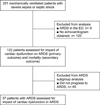The impact of cardiac dysfunction on acute respiratory distress syndrome and mortality in mechanically ventilated patients with severe sepsis and septic shock: an observational study
- PMID: 25179413
- PMCID: PMC4268016
- DOI: 10.1016/j.jcrc.2014.07.027
The impact of cardiac dysfunction on acute respiratory distress syndrome and mortality in mechanically ventilated patients with severe sepsis and septic shock: an observational study
Abstract
Purpose: Acute respiratory distress syndrome (ARDS) is associated with significant mortality and morbidity in survivors. Treatment is only supportive, therefore elucidating modifiable factors that could prevent ARDS could have a profound impact on outcome. The impact that sepsis-associated cardiac dysfunction has on ARDS is not known.
Materials and methods: In this retrospective observational cohort study of mechanically ventilated patients with severe sepsis and septic shock, 122 patients were assessed for the impact of sepsis-associated cardiac dysfunction on incidence of ARDS (primary outcome) and mortality.
Results: Sepsis-associated cardiac dysfunction occurred in 44 patients (36.1%). There was no association of sepsis-associated cardiac dysfunction with ARDS incidence (p= 0.59) or mortality, and no association with outcomes in patients that did progress to ARDS after admission. Multivariable logistic regression demonstrated that higher BMI was associated with progression to ARDS (adjusted OR 11.84, 95% CI 1.24 to 113.0, p= 0.02).
Conclusions: Cardiac dysfunction in mechanically ventilated patients with sepsis did not impact ARDS incidence, clinical outcome in ARDS patients, or mortality. This contrasts against previous investigations demonstrating an influence of nonpulmonary organ dysfunction on outcome in ARDS. Given the frequency of ARDS as a sequela of sepsis, the impact of cardiac dysfunction on outcome should be further studied.
Keywords: Acute respiratory distress syndrome; Cardiac dysfunction; Sepsis.
Copyright © 2014 Elsevier Inc. All rights reserved.
Conflict of interest statement
Conflicts of interest:
All authors declare no conflicts of interest
Figures
Similar articles
-
Sepsis-associated pulmonary complications in emergency department patients monitored with serial lactate: An observational cohort study.J Crit Care. 2015 Dec;30(6):1163-8. doi: 10.1016/j.jcrc.2015.07.031. Epub 2015 Aug 1. J Crit Care. 2015. PMID: 26362864 Free PMC article.
-
The epidemiology of acute respiratory distress syndrome in patients presenting to the emergency department with severe sepsis.Shock. 2013 Nov;40(5):375-81. doi: 10.1097/SHK.0b013e3182a64682. Shock. 2013. PMID: 23903852 Free PMC article.
-
SEX DIFFERENCES IN SEPSIS-RELATED ACUTE RESPIRATORY DISTRESS SYNDROME AND OTHER SHORT-TERM OUTCOMES AMONG CRITICALLY ILL PATIENTS WITH SEPSIS: A RETROSPECTIVE STUDY IN CHINA.Shock. 2025 May 1;63(5):733-742. doi: 10.1097/SHK.0000000000002555. Epub 2025 Feb 4. Shock. 2025. PMID: 39965585 Free PMC article.
-
Surviving sepsis campaign: international guidelines for management of severe sepsis and septic shock: 2012.Crit Care Med. 2013 Feb;41(2):580-637. doi: 10.1097/CCM.0b013e31827e83af. Crit Care Med. 2013. PMID: 23353941
-
Acute lung injury and acute respiratory distress syndrome in sepsis and septic shock.Crit Care Clin. 2000 Apr;16(2):289-317. doi: 10.1016/s0749-0704(05)70111-1. Crit Care Clin. 2000. PMID: 10768083 Review.
Cited by
-
Protective effects of lavender oil on sepsis-induced acute lung injury via regulation of the NF-κB pathway.Pharm Biol. 2022 Dec;60(1):968-978. doi: 10.1080/13880209.2022.2067570. Pharm Biol. 2022. PMID: 35588105 Free PMC article.
-
A bibliometric analysis of sepsis-induced myocardial dysfunction from 2002 to 2022.Front Cardiovasc Med. 2023 Jan 30;10:1076093. doi: 10.3389/fcvm.2023.1076093. eCollection 2023. Front Cardiovasc Med. 2023. PMID: 36793476 Free PMC article.
-
Left ventricular global longitudinal strain is independently associated with mortality in septic shock patients.Intensive Care Med. 2015 Oct;41(10):1791-9. doi: 10.1007/s00134-015-3970-3. Epub 2015 Jul 17. Intensive Care Med. 2015. PMID: 26183489
-
Factors affecting the outcomes in patients with acute respiratory distress syndrome in a tertiary care setting.Clin Epidemiol Glob Health. 2022 Jan-Feb;13:100972. doi: 10.1016/j.cegh.2022.100972. Epub 2022 Jan 18. Clin Epidemiol Glob Health. 2022. PMID: 37309426 Free PMC article.
-
Haemodynamic Effects of Lung Recruitment Manoeuvres.Biomed Res Int. 2015;2015:478970. doi: 10.1155/2015/478970. Epub 2015 Nov 22. Biomed Res Int. 2015. PMID: 26682219 Free PMC article. Review.
References
-
- Angus DC, Linde-Zwirble WT, Lidicker J, Clermont G, Carcillo J, Pinsky MR. Epidemiology of severe sepsis in the United States: analysis of incidence, outcome, and associated costs of care. Critical care medicine. 2001;29(7):1303–1310. - PubMed
-
- Martin GS, Mannino DM, Eaton S, Moss M. The epidemiology of sepsis in the United States from 1979 through 2000. New England Journal of Medicine. 2003;348(16):1546–1554. - PubMed
-
- Rubenfeld GD, Herridge MS. Epidemiology and Outcomes of Acute Lung Injury*. Chest. 2007;131(2):554–562. - PubMed
-
- Rubenfeld GD, Caldwell E, Peabody E, Weaver J, Martin DP, Neff M, Stern EJ, Hudson LD. Incidence and outcomes of acute lung injury. New England Journal of Medicine. 2005;353(16):1685–1693. - PubMed
Publication types
MeSH terms
Grants and funding
LinkOut - more resources
Full Text Sources
Other Literature Sources
Medical



